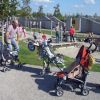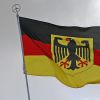The reinvention of cities
People worldwide are being drawn to cities. Germany is preparing for this far-reaching change with smart solutions.

The 21th century is considered the century of cities. Never before have so many people lived in urban centres, and the shift from country to city is continuing. Yet cities in their present form are huge consumers of resources that offer no chance of ecological sustainability. The scale of change anticipated by experts is immense. Two to three billion of the current total of over seven billion people on Earth will surge into the cities during the next few decades. The largest migratory movement in human history has begun. This worldwide trend, which the Scientific Advisory Council on Global Change (WBGU) describes in its latest report to the Federal Government, applies equally to Germany. There is also a constant flow of people moving from the country to the cities between Flensburg and Garmisch. Some 75% of the population of roughly 81.5 million people now live in areas with high or medium population densities. There are 76 towns with over 100,000 inhabitants in Germany. In particular, cities such as Berlin and Frankfurt am Main have been experiencing continuous ongoing growth since the 2000s. “Germans are moving into cities, where the distances are short, the opportunities greater and the offerings more varied and where – very importantly – it is easier to reconcile having a family and a career,” is how the daily Frankfurter Allgemeine Zeitung describes this trend. Germany is considered a perfect example of a country characterised by urban life. Experts regard the renaissance of the city as an ongoing development for growth and innovation and currently forecast rapidly rising population figures for cities until 2030 – with significant consequences for the housing market, including rents and property prices, inner city transport systems and infrastructure generally.
For a number of years now, the digital “smart city” has served as a vision of the future for urban development, firing the imagination of urban planners on all continents. This is because information and communications technology (ICT) enables the smart city to control urban flows of goods and traffic more efficiently with a lower energy footprint.
Looking into the future also shows city planners an urban development ideal with many smaller urban centres instead of one all-devouring metropolis. Within this “polycentric townscape”, as urbanists call it, industry once again finds room in the urban space, although it is in a brand-new post-industrial form: as factories that emit neither noise nor poisonous gases. New, smart manufacturing methods like 3D printing could even ring in a renaissance of the Kreuzberg Mix, a model involving apartments and workshops in one complex of buildings which was widespread in Berlin during the 19th century. “The decentralised production of renewable energies, the closed-loop economy based on recycling and also the digital economy are making it possible to reduce the density of cities,” says Professor Hans Joachim Schellnhuber of the Potsdam Institute for Climate Impact Research, who is also Chairman of the WBGU. He points to examples of where he has observed urban “de-intensification”: “The polycentric integration of regions like the Ruhr District in Germany, which is currently reinventing itself, or the San Francisco Bay Area can become models for the urbanity of tomorrow.”
The main driving force behind the changing urban-rural relationship in Germany is – as it has always been since the advent of industrialisation – the migration of the young to jobs in urban areas where the greatest career and development opportunities await them. The age group of 18 to 24 year olds demonstrates an especially high readiness to move to cities. In Germany, this process of outward migration will above all continue to apply to the states in eastern Germany.
The winners of this development are primarily the affluent suburbs of large towns and metropolitan regions. In addition to this, the rural population is steadily aging, while the urban population is becoming younger. Although population researchers anticipate an overall reduction in the German population of 0.7% by the year 2030, they are forecasting growth rates of up to 10% for cities like Berlin and Hamburg. The economically powerful southern states of Bavaria and Baden-Württemberg with their numerous dynamic medium-sized towns are also expected to experience population increases in the medium term.
However, the technological transformation of metropolitan regions into smart cities will not happen of its own accord. If a further 700 million people worldwide do actually move to the cities in the next ten years, there is a danger of infrastructure collapse in many places. The McKinsey management consultancy estimates that by 2025 large cities will have to double their annual investments in energy, water, waste water and inner-city transport systems compared to the 2013 total of 10,000 billion US dollars.
Nevertheless, urban development researchers would not like to regard the requisite change as a purely technological matter. In the opinion of Martin zur Nedden, Executive Director of the German Institute of Urban Affairs (DIFU) in Berlin, German cities face four major challenges in coming years: climate change and requisite adjustments, the demographic transformation resulting from an ageing population, tendencies towards social segregation and achieving increased citizen participation. “Elements of the sharing economy and citizen participation belong to the city of the future,” emphasises the DIFU Executive Director. The municipal expert also reminds us of the “model of the European city” that was supposed to be taken into account in future developments. Its key elements were: historicity, the expectation of emancipation, the urban way of life, architectural design quality and the planned city.
Armin Grunwald, an expert on technological impact assessment at the Karlsruhe Institute of Technology, also warns against an excessively one-sided focus on technology on the threshold to a “new city”. Residents must be at the centre of the city of the future. According to Grunwald, important questions that need to be answered concern the relationships between town and country, sustainability, social exclusion and inclusion, cultural urbanity and the tension between people and technology. Grunwald strongly urges pursuing a concept of “co-design” that does “not plan technology for humans, but with them”.
You can experience an example of what co-design means in Wuppertal (North Rhine-Westphalia). This is where researchers from the Wuppertal Institute for Climate, Environment and Energy are increasingly making a concrete contribution to “urban change” with new forms of mobility. Institute Director Uwe Schneidewind believes it will be possible in the long term to “reduce car ownership in Wuppertal to one tenth of its present amount” with the aid of new technologies, such as driverless vehicles, social “sharing” models of car use and a citizens’ ticket for buses and trains. The urban space would be profoundly changed by a smart transport solution of this kind.
Perhaps, however, the technology megatrend of digitalisation has yet another surprise in store. Initial signs are emerging that improved Internet connectivity and the expansion of an appropriate Web economy with “locationless business models” could give rural regions a new advantage because of their proximity to nature. A similar development has already occurred once before: it began in the 1960s when the spread of car ownership made living in the country attractive. It cannot be ruled out that the upgrading of broadband connections could attract newcomers from the mobile Internet generation to supposedly lost regions. Technological development is full of unexpected surprises. ▪

